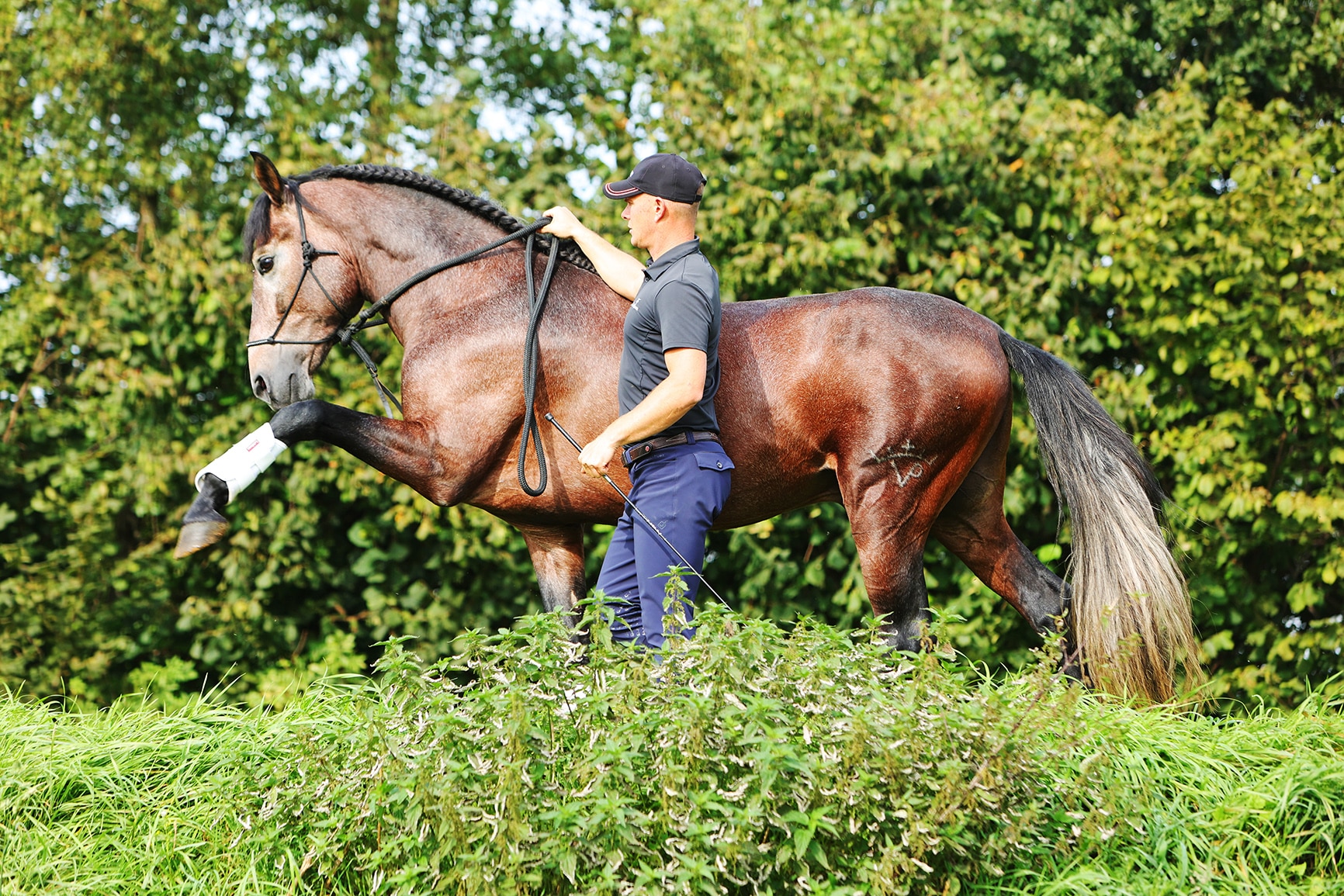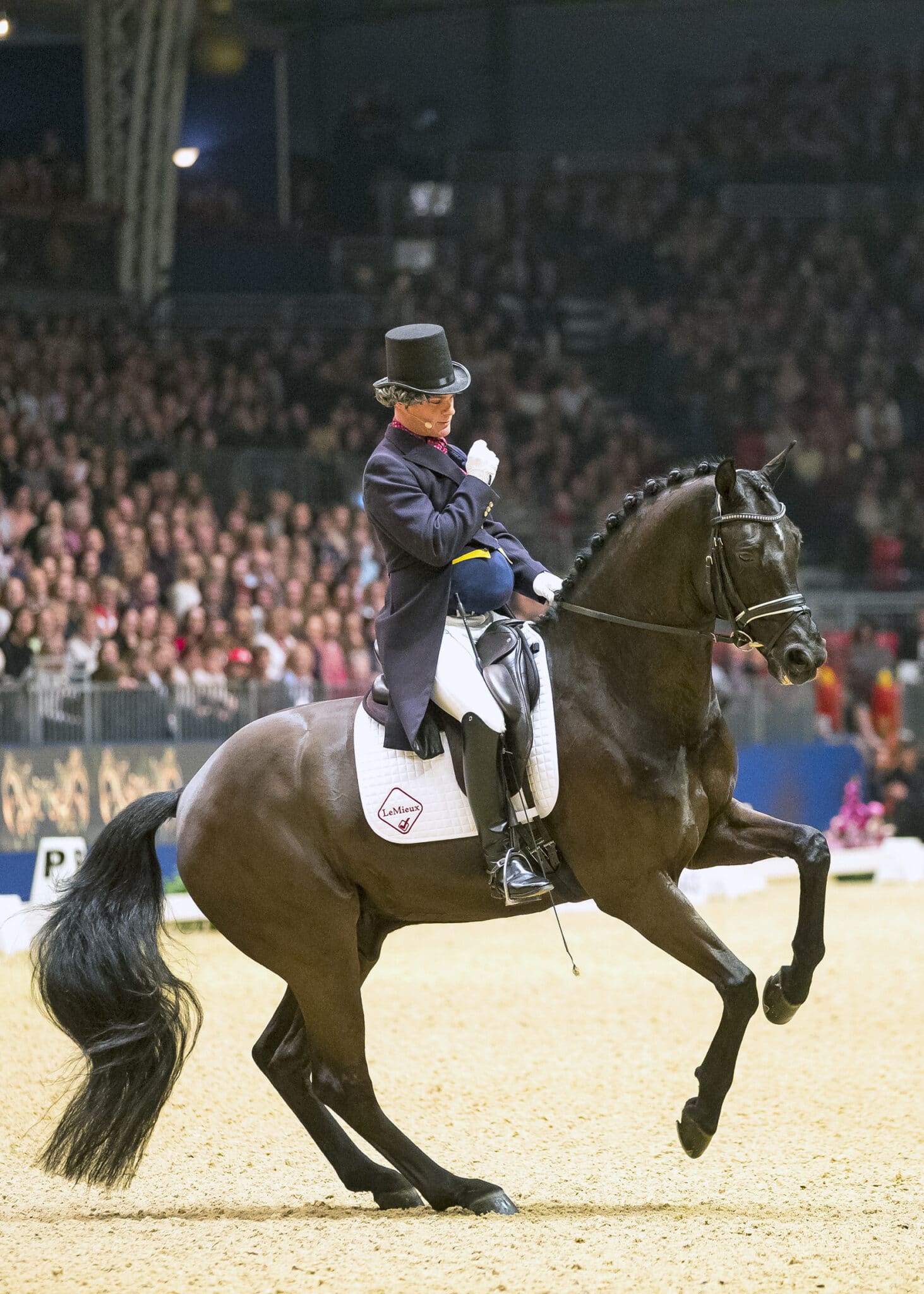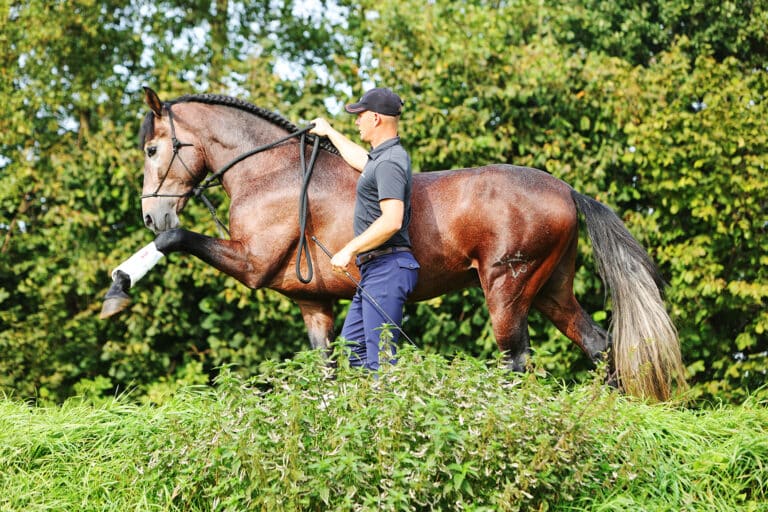
Tristan Tucker and the art of Zen
Tristan Tucker has an enviable way with horses. But it’s not an ability that developed overnight, it evolved over a number of years. AMANDA MAC investigates.
Other than perhaps the occasional quizzical glance in his direction, the horses that Tristan Tucker works with remain cool and composed as he cracks whips, waves umbrellas, and unfurls flags over and around them. So, what is it about Tristan’s method that lulls his protégés into this calm, Zen-like state?
Now an internationally recognised horseman, trainer, educator and Grand Prix dressage rider, who occasionally masquerades as the hilarious Brett Kidding, he has worked hard to accomplish all he has achieved – and it certainly didn’t happen overnight.
Born in Cornwall in the UK, his parents emigrated to Australia just before Tristan’s first birthday. The family settled in Melbourne where his mother, who loved horses, worked in a racing stable. Growing up around horses as he did, he was desperate for a pony of his own, and his parents were happy to oblige.
However, Tristan also loved motorbikes: “I’d started at Mentone Pony Club and was eventing and jumping with the pony and racing bikes every other weekend, which became an expensive exercise for my parents,” he explains. Inevitably, crunch time came and he was asked to choose between the two sports, and, since he’d crashed his bike a few weeks earlier, he opted for horses!
Fast forward a few years and Tristan was lucky enough to meet a visiting Danish trainer who helped him improve his dressage, which had become his discipline of choice. At the time, he was also riding track work, driving trotting horses, and retraining off the track Thoroughbreds, all of which honed his horsemanship skills. “I was exposed to a lot of different types and breeds, and everything sort of grew from there,” he tells me.
But like many parents, Tristan’s were keen for him to get a degree. So, he went to university and completed a finance and a visual arts degree while continuing to work with horses. With the degree box ticked, in late 1999 Tristan travelled to Europe (the first of many trips) with Morten Thompson, his longtime mentor and dressage coach.

While Tristan learned a lot from his teachers in Europe, he also had very good mentors at home in Australia. “I was riding for Heatherton Park, owned by Jim and Emmie Schmul, who were great mentors not only in horses, competing, and making a name for myself, but also in business and life in general.”
Their business mentorship certainly came in handy. After buying a property some 60 kilometres from Melbourne’s CBD, Tristan had launched his own brand and business and was starting up to 100 horses a year. It was a busy and successful time, but he had begun to feel isolated. “I realised that if I wanted to expand my knowledge and experience, then Europe was the place to be.”
His decision made, he relocated to The Netherlands, which became home to his TRT Equestrian brand and later, in collaboration with his business partner, to the TRT Method. But, as Tristan points out, that method had been developing from the first contact he’d ever had with a horse. “And it’s still evolving,” he adds.
Delivered online, the TRT Method has attracted 56,000 members from 74 countries, and the success stories are truly remarkable. But obviously, Tristan’s isn’t the only training program available, so what’s his point of difference? “That comes from my influences and where my focus has been,” he explains, “and that’s to build a self-management system that gives the horse the skills to know what to do with themselves in all the situations within our human world, which are, of course, not the skills they’re born with. So, we’re not teaching people how to control their horses, we’re teaching people how to teach their horses to be in control of themselves.”
The TRT Method slogan is ‘to create a life for horses better than nature intended’, a philosophy that underpins Tristan’s unique approach. “Because we bring horses into our environment, it’s our responsibility to equip them. It’s our job to give them the skills so that there are less moments of insecurity and uncertainty; so that they’re able to thrive through the knowledge and understanding of how to manage themselves in the presence of everything they’re presented with in a life with humans.”
Among the many horses he’s worked with, Tristan says he hasn’t found one yet that he wasn’t able to shift from ‘survival mode’ into a place in which they felt comfortable, relaxed and happy in their own skin. Ironically, it’s a horse’s human that sometimes presents more of a challenge! “It’s difficult when the owner isn’t prepared to let go of their preconceived ideas of what they want for that horse. But not all horses are suited physically or mentally, or have had the life experience to make it easy for them to perform in a particular discipline. However, it’s for sure possible for every horse to get to the stage where they find a place of comfort and ease.”

While Tristan is very serious indeed when it comes to being the best mentor he can be for the horses he meets, he gives his wicked sense of humour free rein when he steps into the skin of Brett Kidding – and if you haven’t already been entertained by Brett’s antics in the dressage arena, now’s the time!
Brett came about after Tristan had spent a very cold winter in Germany, attempting to convince the German Equestrian Federation that his philosophy might enhance the lives of horses operating within the traditional aspects of the sport.
Increasingly frustrated in his efforts, he had a call from Carl Hester and Richard Davison, who were running The Dressage Convention in the UK, asking him to come and give a demonstration, assuring him that whatever he wanted to do would be OK with them. Wanting a contrast to the seriousness of his months in Germany, he decided to showcase what the TRT Method could achieve in a comical way.
With that in mind, Tristan settled on the persona of John Notaclue, an Englishman with few horsemanship skills. But concerned that it wouldn’t go down well with a largely English audience, Carl and John advised him to present the skit as an Aussie. “Richard was wondering what a recognisably Aussie name might be. Carl suggested Brett, Richard said ‘You’re kidding, aren’t you?’, and Carl said ‘That’s it! Brett Kidding’.” Tristan laughs at the memory.
Tristan had a few points to prove as his alter ego. “Brett’s the guy who’s not giving much support to his horse at all, and yet the horse is still able to go through Grand Prix and perform all the movements happily under their own responsibility and motivation. I wanted to show that your horse can be in control of their own physical and mental soundness, and that if we teach them what the job is, then they’re able to actually do it.”
He was also determined to address some of the less positive aspects of the sport. “There’s pressure around what we should be doing in the ring and how we should be presenting ourselves in order to become successful dressage riders, which in turn creates unnecessary pressure on the horse – and that can ruin the experience for them as well as for ourselves. So I wanted to make some cracks in that culture, to bring some humour and some self-reflection, and to allow people to laugh at themselves by laughing at me.”
Could it be that by creating empowered, relaxed horses, Tristan’s TRT Method also creates confident and happy riders? Something Zen for you to ponder.
Visit the TRT Method to learn more about their range of courses.

